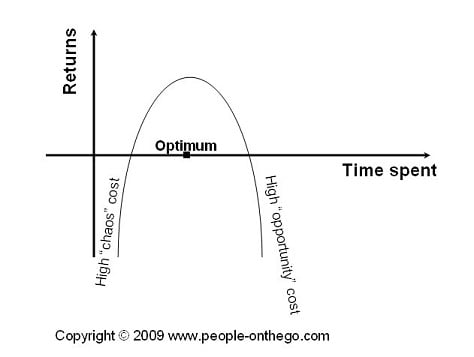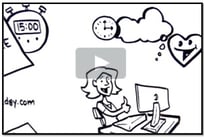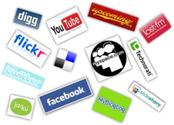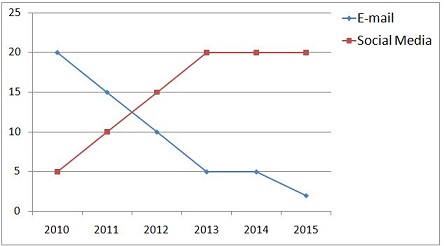It seems that many of the people we talk to fall in one of these two categories. Either they spend too much time on organizing (these are the persistent few) or they have largely given up on organization (the more common scenario) and they feel out of control most of the time. Is there however an optimum amount of organization that would be feasible for most of us and yet give us the best return?
This graph, which resembles to some degree the Results Curve(tm) graph that I have been teaching in our Accomplishing More With Less workshop and workbook, describes the returns that we get from the time spent on organization, and below are some related note:

- There is a minimum amount of organization that we all need, and without it, our lives are likely to be chaotic, stressful, and unfulfilled.
- The minimum amount of organization is a lot less than what you might think, and if done strategically, it is likely to bring big returns.
- There is an optimum amount of organization that if we go beyond it, we would be doing so at the expense of more important activities and therefore incur a very high opportunity cost.
- Both lack of organization as well as organizing beyond the optimum point are equally disadvantageous. While Eric Abrahamson and David H. Freedman, authors of A Perfect Mess, suggest that disorder is far more advantageous than order (and that most organizational systems are a waste of time), I wouldn't go that far. I promote an optimum level or organization which I also believe is different for each person.
Your to-do's
- Reflect on where you are on the organizational curve above and find out where you are on this scale.
- If you think you are under-organized, identify an area where some additional organization would give you high returns and act on it.
- If you think you are over-organized at the expense of more important initiative and activities, identify an area where you can reduce your effort and make room for more strategic things.
- Keep an eye on organizational tips and see what might work for you. Subscribe to this blog and to similar ones and contribute your comments and get engaged!







 Apple users would say Apple is the answer, but if you don't to go that far and many of us can't go that far, I am pleasantly surprised by Windows 7, and so far it is demonstrating that it may be the answer.
Apple users would say Apple is the answer, but if you don't to go that far and many of us can't go that far, I am pleasantly surprised by Windows 7, and so far it is demonstrating that it may be the answer.  E-mail is overused and even abused, and users' mailboxes are congested--worse than traffic in the busiest metropolitan areas of the world. People are tired of scrolling up and down the inbox and many stopped looking at, and not to mention responding to, e-mail messages except for the urgent messages from their bosses or customers. Reaching people via e-mail (unless you are their boss or customer) has become quite challenging. It is "extreme" e-mail fatigue that we are suffering from. So many things fall through the cracks and so many inefficiencies are invading the work place and our personal lives. Does this sound like "chaos"? Well it is!
E-mail is overused and even abused, and users' mailboxes are congested--worse than traffic in the busiest metropolitan areas of the world. People are tired of scrolling up and down the inbox and many stopped looking at, and not to mention responding to, e-mail messages except for the urgent messages from their bosses or customers. Reaching people via e-mail (unless you are their boss or customer) has become quite challenging. It is "extreme" e-mail fatigue that we are suffering from. So many things fall through the cracks and so many inefficiencies are invading the work place and our personal lives. Does this sound like "chaos"? Well it is! While Web 2.0 tools (such as blogs, wikis, and Microsoft SharePoint) are emerging as the better alternatives for collaboration and information sharing, in this post, I am interested in focusing on the Social Media platforms and reflecting on their relationship to e-mail today and in the future.
While Web 2.0 tools (such as blogs, wikis, and Microsoft SharePoint) are emerging as the better alternatives for collaboration and information sharing, in this post, I am interested in focusing on the Social Media platforms and reflecting on their relationship to e-mail today and in the future.
 Environmentally aware consumers are producing less waste by practicing the "3 Rs": Reduce. Reuse. Recycle. When it comes to productivity and accomplishments, we can use these same guidelines and reap some enormous benefits:
Environmentally aware consumers are producing less waste by practicing the "3 Rs": Reduce. Reuse. Recycle. When it comes to productivity and accomplishments, we can use these same guidelines and reap some enormous benefits: Whehter your are delivering online courses as part of a corporate training program, a keynote speech at a virtual conference, or marketing and sales webinars to promote your products and services, here are some pointers for making your webinar successful:
Whehter your are delivering online courses as part of a corporate training program, a keynote speech at a virtual conference, or marketing and sales webinars to promote your products and services, here are some pointers for making your webinar successful: Something unique happens when we dive into and fully commit our energy to one task while letting everything else fade in the background. This forces us to go deeper and prompt us into moving the issues forward, into finding solutions, or even making breakthroughs. This is likely to unleash new levels of creativity, resourcefulness, and capabilities we may not even know we have.
Something unique happens when we dive into and fully commit our energy to one task while letting everything else fade in the background. This forces us to go deeper and prompt us into moving the issues forward, into finding solutions, or even making breakthroughs. This is likely to unleash new levels of creativity, resourcefulness, and capabilities we may not even know we have. You have this report to write, or presentation to prepare, or project plan to put into place. It is daunting. Too many parts to it. Too many issues to think about. You find yourself deferring it and feeling a little anxious when you think about it. It is just too big of an undertaking, and/or a sign of procrastination, and/or a sign of wanting it to be nothing less than perfect . You end up delaying it until there is no room for delaying any further. Then it becomes a high pressure situation. In addition, work quality suffers. If other urgent demands come up at the same time, and they will, then you've got one of these "situations" on hand.
You have this report to write, or presentation to prepare, or project plan to put into place. It is daunting. Too many parts to it. Too many issues to think about. You find yourself deferring it and feeling a little anxious when you think about it. It is just too big of an undertaking, and/or a sign of procrastination, and/or a sign of wanting it to be nothing less than perfect . You end up delaying it until there is no room for delaying any further. Then it becomes a high pressure situation. In addition, work quality suffers. If other urgent demands come up at the same time, and they will, then you've got one of these "situations" on hand. You have this long to-do list, and items keep getting added to it, and the list gets longer and longer. So what do you do? Here are three suggestions that can help.
You have this long to-do list, and items keep getting added to it, and the list gets longer and longer. So what do you do? Here are three suggestions that can help.
